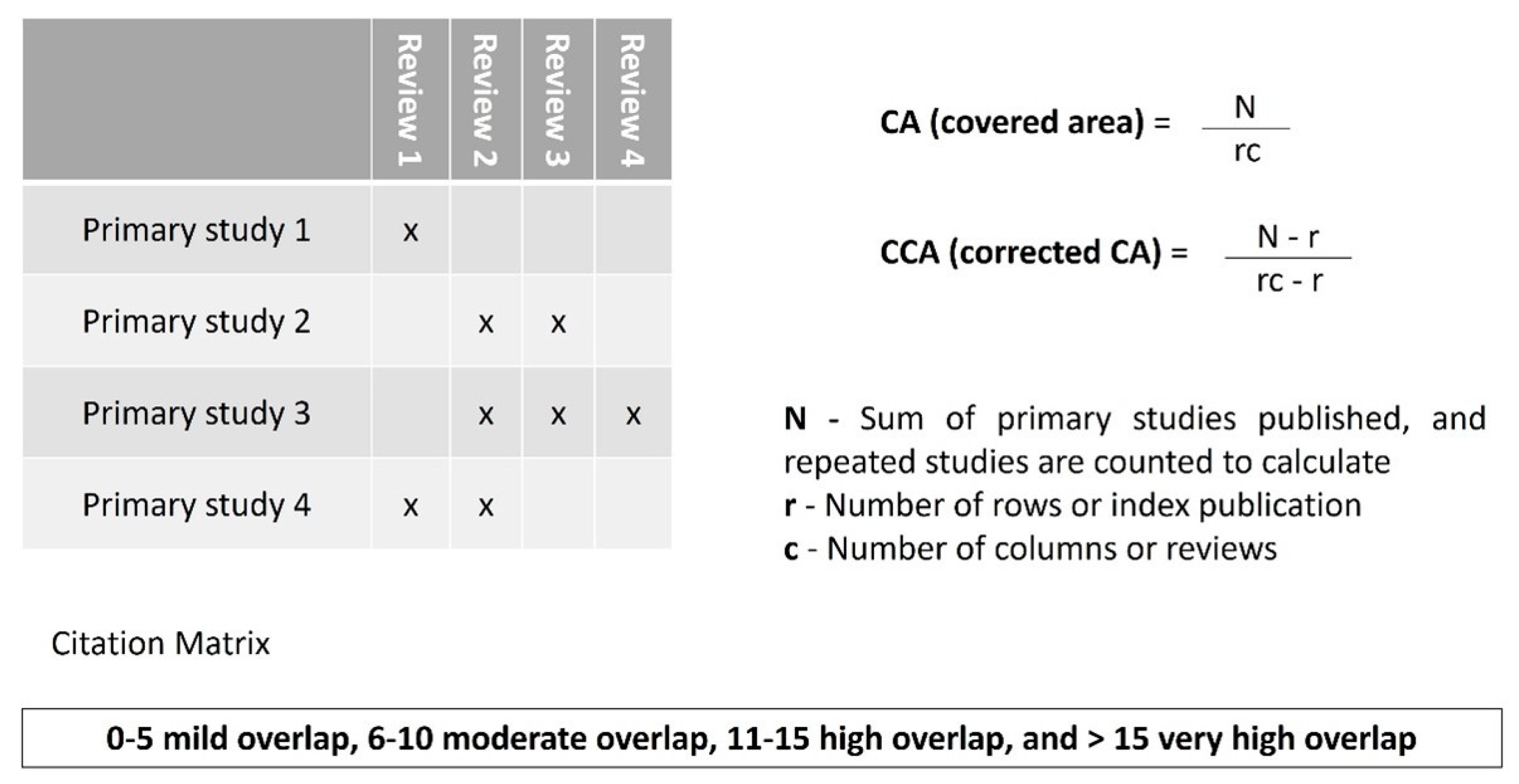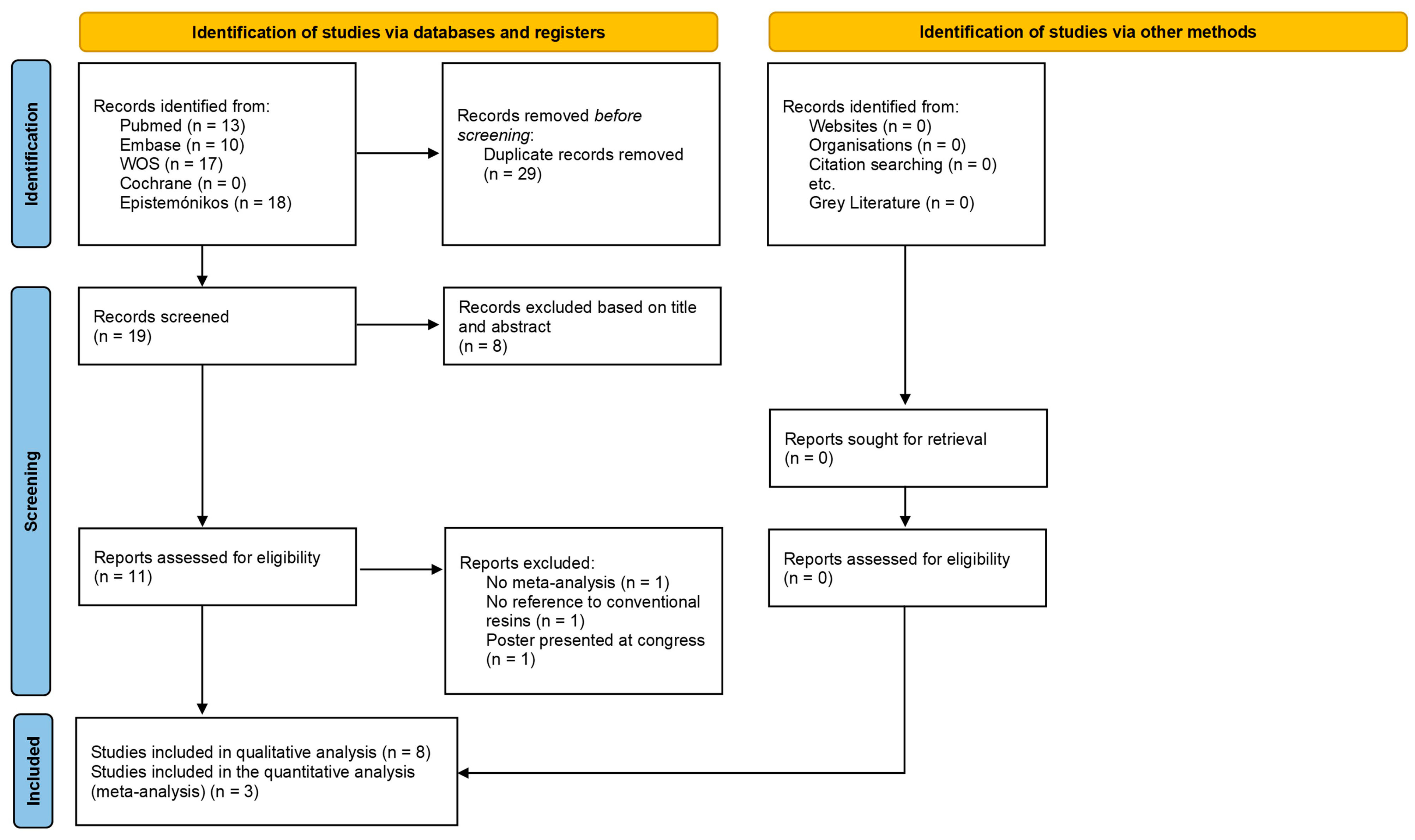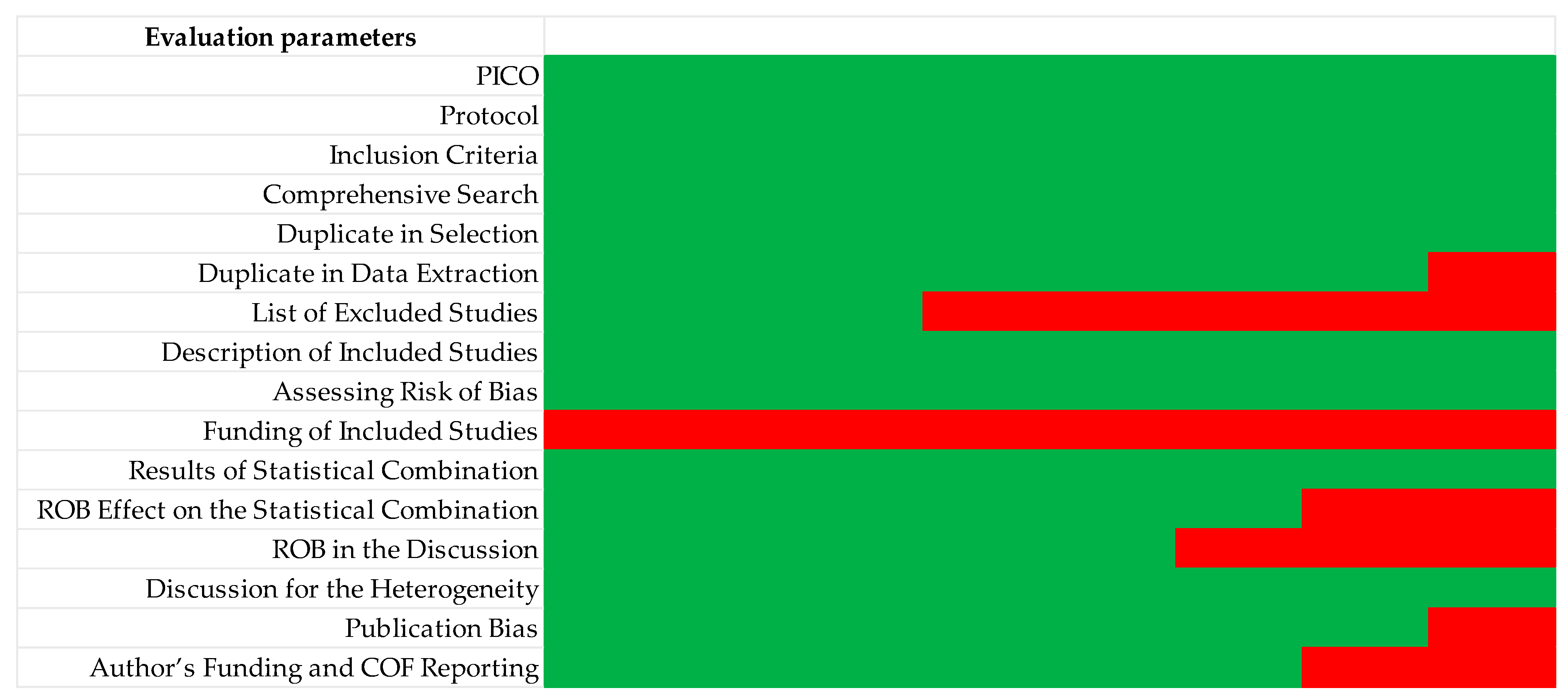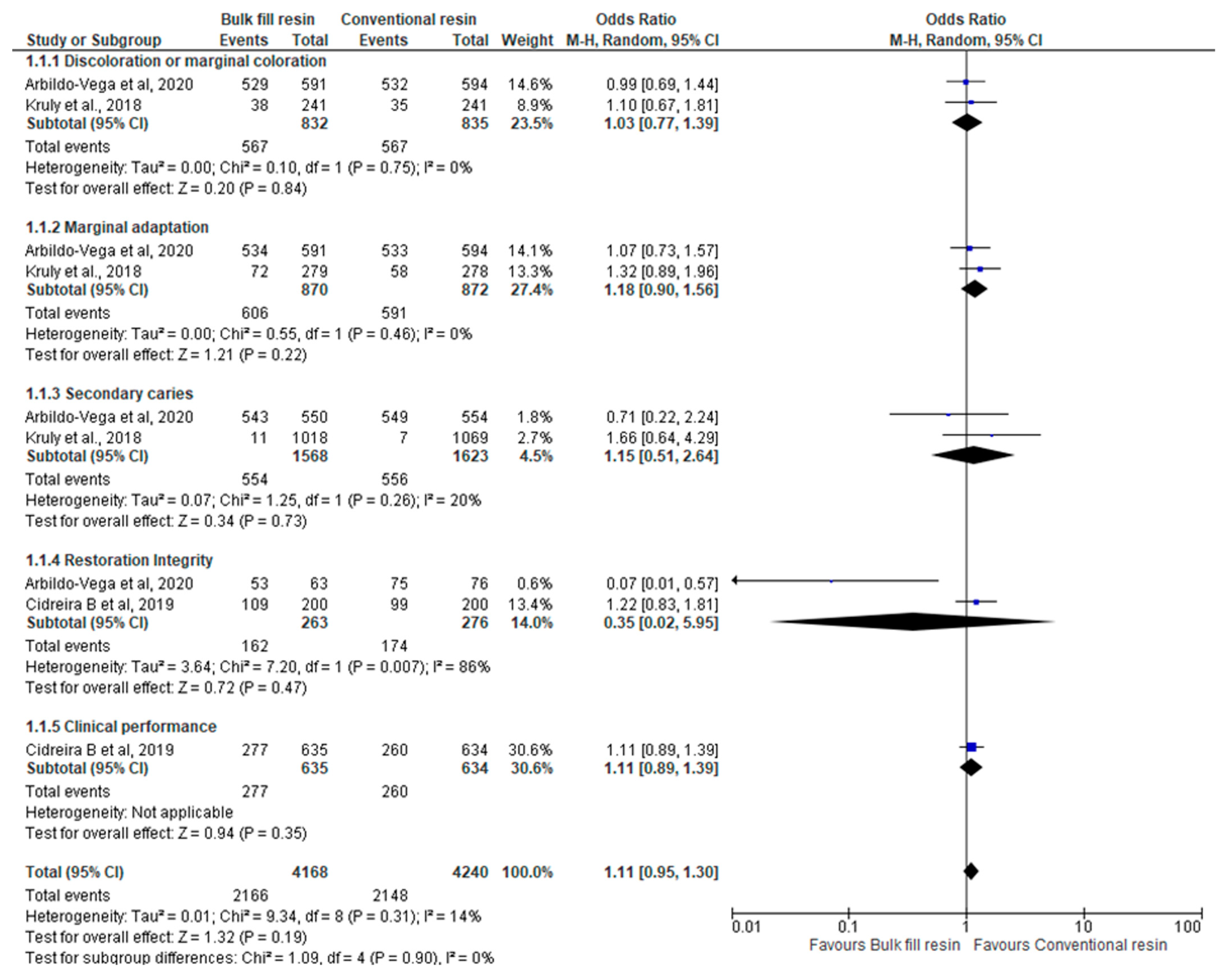Bulk-Fill Resins versus Conventional Resins: An Umbrella Review
Abstract
1. Introduction
2. Materials and Methods
2.1. Protocol Registration
2.2. Review Question
2.3. Search Strategy
2.4. Eligibility Criteria
2.5. Data Extraction and Meta-Analysis
2.6. Quality and Risk of Bias Assessment
2.7. Analysis of the Degree of Overlap in Studies
3. Results
3.1. Study Selection
3.2. Characteristics of the Included Reviews
3.3. Meta-Analysis
3.4. Quality of the Included Reviews
3.5. Degree of Umbrella Review’ Overlap
1652 = 0.025
4. Discussion
5. Conclusions
Supplementary Materials
Author Contributions
Funding
Institutional Review Board Statement
Informed Consent Statement
Data Availability Statement
Conflicts of Interest
References
- Arbildo-Vega, H.I.; Lapinska, B.; Panda, S.; Lamas-Lara, C.; Khan, A.S.; Lukomska-Szymanska, M. Clinical Effectiveness of Bulk-Fill and Conventional Resin Composite Restorations: Systematic Review and Meta-Analysis. Polymers 2020, 12, 1786. [Google Scholar] [CrossRef]
- Chesterman, J.; Jowett, A.; Gallacher, A.; Nixon, P. Bulk-Fill Resin-Based Composite Restorative Materials: A Review. Br. Dent. J. 2017, 222, 337–344. [Google Scholar] [CrossRef] [PubMed]
- Goldman, M. Polymerization Shrinkage of Resin-Based Restorative Materials. Aust. Dent. J. 1983, 28, 156–161. [Google Scholar] [CrossRef]
- Alomari, Q.D.; Reinhardt, J.W.; Boyer, D.B. Effect of Liners on Cusp Deflection and Gap Formation in Composite Restorations. Oper. Dent. 2001, 26, 406–411. [Google Scholar] [PubMed]
- Lee, M.-R.; Cho, B.-H.; Son, H.-H.; Um, C.-M.; Lee, I.-B. Influence of Cavity Dimension and Restoration Methods on the Cusp Deflection of Premolars in Composite Restoration. Dent. Mater. 2007, 23, 288–295. [Google Scholar] [CrossRef] [PubMed]
- Roberto, L.G.; Francesco, P.; Carmine, V.; Marco, M.; Angela, A.; Angelo, L. Bulk vs. Wedge Shape Layering Techniques in V Class Cavities: Marginal Infiltration Evaluation. G. Ital. Endod. 2017, 31, 73–77. [Google Scholar] [CrossRef]
- Park, J.; Chang, J.; Ferracane, J.; Lee, I.B. How Should Composite Be Layered to Reduce Shrinkage Stress: Incremental or Bulk Filling? Dent. Mater. 2008, 24, 1501–1505. [Google Scholar] [CrossRef]
- Krifka, S.; Federlin, M.; Hiller, K.-A.; Schmalz, G. Microleakage of Silorane- and Methacrylate-Based Class V Composite Restorations. Clin. Oral. Investig. 2012, 16, 1117–1124. [Google Scholar] [CrossRef] [PubMed]
- Zanatta, R.; Torres, C.; de Oliveira, J.; Yui, K.; Matuda, A.; Lopes, S.; Mafetano, A.; Campos, R.; Borges, A.; Pucci, C. Minimal Intervention in Dentistry: Which Is the Best Approach for Silorane Composite Restoration Repairs? J. Clin. Exp. Dent. 2021, 13, e357–e362. [Google Scholar] [CrossRef]
- Monsarrat, P.; Garnier, S.; Vergnes, J.-N.; Nasr, K.; Grosgogeat, B.; Joniot, S. Survival of Directly Placed Ormocer-Based Restorative Materials: A Systematic Review and Meta-Analysis of Clinical Trials. Dent. Mater. 2017, 33, e212–e220. [Google Scholar] [CrossRef]
- Abreu, N.M.; Sousa, F.B.; Dantas, R.V.; Leite, P.K.; Batista, A.U.; Montenegro, R.V. Longevity of Bulk Fill and Ormocer Composites in Permanent Posterior Teeth: Systematic Review and Meta-Analysis. Am. J. Dent. 2022, 35, 89–96. [Google Scholar] [PubMed]
- Leprince, J.G.; Palin, W.M.; Vanacker, J.; Sabbagh, J.; Devaux, J.; Leloup, G. Physico-Mechanical Characteristics of Commercially Available Bulk-Fill Composites. J. Dent. 2014, 42, 993–1000. [Google Scholar] [CrossRef]
- Francesco, P.; Gabriele, C.; Fiorillo, L.; Giuseppe, M.; Antonella, S.; Giancarlo, B.; Mirta, P.; Mendes Tribst, J.P.; Lo Giudice, R. The Use of Bulk Fill Resin-Based Composite in the Sealing of Cavity with Margins in Radicular Cementum. Eur. J. Dent. 2022, 16, 1–13. [Google Scholar] [CrossRef]
- Reis, A.F.; Vestphal, M.; do Amaral, R.C.; Rodrigues, J.A.; Roulet, J.-F.; Roscoe, M.G. Efficiency of Polymerization of Bulk-Fill Composite Resins: A Systematic Review. Braz. Oral. Res. 2017, 31, e59. [Google Scholar] [CrossRef] [PubMed]
- Van Ende, A.; De Munck, J.; Lise, D.P.; Van Meerbeek, B. Bulk-Fill Composites: A Review of the Current Literature. J. Adhes. Dent. 2017, 19, 95–109. [Google Scholar] [CrossRef]
- Van Ende, A.; De Munck, J.; Van Landuyt, K.L.; Poitevin, A.; Peumans, M.; Van Meerbeek, B. Bulk-Filling of High C-Factor Posterior Cavities: Effect on Adhesion to Cavity-Bottom Dentin. Dent. Mater. 2013, 29, 269–277. [Google Scholar] [CrossRef] [PubMed]
- Hasanain, F.A.; Nassar, H.M.; Ajaj, R.A. Effect of Light Curing Distance on Microhardness Profiles of Bulk-Fill Resin Composites. Polymers 2022, 14, 528. [Google Scholar] [CrossRef] [PubMed]
- Ajaj, R.; Farsi, N.; Alzain, L.; Nuwaylati, N.; Ghurab, R.; Nassar, H. Dental Bulk-Fill Resin Composites Polymerization Efficiency: A Systematic Review and Meta-Analysis. J. Compos. Sci. 2021, 5, 149. [Google Scholar] [CrossRef]
- Peutzfeldt, A.; Mühlebach, S.; Lussi, A.; Flury, S. Marginal Gap Formation in Approximal “Bulk Fill” Resin Composite Restorations after Artificial Ageing. Oper. Dent. 2018, 43, 180–189. [Google Scholar] [CrossRef]
- Ilie, N.; Hilton, T.J.; Heintze, S.D.; Hickel, R.; Watts, D.C.; Silikas, N.; Stansbury, J.W.; Cadenaro, M.; Ferracane, J.L. Academy of Dental Materials Guidance—Resin Composites: Part I—Mechanical Properties. Dent. Mater. 2017, 33, 880–894. [Google Scholar] [CrossRef]
- Page, M.J.; McKenzie, J.E.; Bossuyt, P.M.; Boutron, I.; Hoffmann, T.C.; Mulrow, C.D.; Shamseer, L.; Tetzlaff, J.M.; Akl, E.A.; Brennan, S.E.; et al. The PRISMA 2020 Statement: An Updated Guideline for Reporting Systematic Reviews. BMJ 2021, 372, n71. [Google Scholar] [CrossRef]
- Shea, B.J.; Reeves, B.C.; Wells, G.; Thuku, M.; Hamel, C.; Moran, J.; Moher, D.; Tugwell, P.; Welch, V.; Kristjansson, E.; et al. AMSTAR 2: A Critical Appraisal Tool for Systematic Reviews That Include Randomised or Non-Randomised Studies of Healthcare Interventions, or Both. BMJ 2017, 358, j4008. [Google Scholar] [CrossRef]
- Pieper, D.; Antoine, S.-L.; Mathes, T.; Neugebauer, E.A.M.; Eikermann, M. Systematic Review Finds Overlapping Reviews Were Not Mentioned in Every Other Overview. J. Clin. Epidemiol. 2014, 67, 368–375. [Google Scholar] [CrossRef] [PubMed]
- Bougioukas, K.I.; Vounzoulaki, E.; Mantsiou, C.D.; Savvides, E.D.; Karakosta, C.; Diakonidis, T.; Tsapas, A.; Haidich, A.-B. Methods for Depicting Overlap in Overviews of Systematic Reviews: An Introduction to Static Tabular and Graphical Displays. J. Clin. Epidemiol. 2021, 132, 34–45. [Google Scholar] [CrossRef]
- Seifo, N.; Cassie, H.; Radford, J.R.; Innes, N.P.T. Silver Diamine Fluoride for Managing Carious Lesions: An Umbrella Review. BMC Oral. Health 2019, 19, 145. [Google Scholar] [CrossRef] [PubMed]
- Arian, M.; Valinejadi, A.; Soleimani, M. Calculate the Actual Overlap in an Overview. Nurs. Pract. Today 2021, 8, 91–95. [Google Scholar] [CrossRef]
- Bellinaso, M.D.; Soares, F.Z.M.; Rocha, R.d.O. Do Bulk-Fill Resins Decrease the Restorative Time in Posterior Teeth? A Systematic Review and Meta-Analysis of In Vitro Studies. J. Investig. Clin. Dent. 2019, 10, e12463. [Google Scholar] [CrossRef]
- Cidreira Boaro, L.C.; Pereira Lopes, D.; de Souza, A.S.C.; Lie Nakano, E.; Ayala Perez, M.D.; Pfeifer, C.S.; Gonçalves, F. Clinical Performance and Chemical-Physical Properties of Bulk Fill Composites Resin—A Systematic Review and Meta-Analysis. Dent. Mater. 2019, 35, e249–e264. [Google Scholar] [CrossRef]
- Gerula-Szymańska, A.; Kaczor, K.; Lewusz-Butkiewicz, K.; Nowicka, A. Marginal Integrity of Flowable and Packable Bulk Fill Materials Used for Class II Restorations —A Systematic Review and Meta-Analysis of In Vitro Studies. Dent. Mater. J 2020, 39, 335–344. [Google Scholar] [CrossRef] [PubMed]
- de Kruly, P.C.; Giannini, M.; Pascotto, R.C.; Tokubo, L.M.; Suga, U.S.G.; Marques, A.d.C.R.; Terada, R.S.S. Meta-Analysis of the Clinical Behavior of Posterior Direct Resin Restorations: Low Polymerization Shrinkage Resin in Comparison to Methacrylate Composite Resin. PLoS ONE 2018, 13, e0191942. [Google Scholar] [CrossRef]
- Meereis, C.T.W.; Münchow, E.A.; de Oliveira da Rosa, W.L.; da Silva, A.F.; Piva, E. Polymerization Shrinkage Stress of Resin-Based Dental Materials: A Systematic Review and Meta-Analyses of Composition Strategies. J. Mech. Behav. Biomed. Mater. 2018, 82, 268–281. [Google Scholar] [CrossRef]
- Veloso, S.R.M.; Lemos, C.A.A.; de Moraes, S.L.D.; do Egito Vasconcelos, B.C.; Pellizzer, E.P.; de Melo Monteiro, G.Q. Clinical Performance of Bulk-Fill and Conventional Resin Composite Restorations in Posterior Teeth: A Systematic Review and Meta-Analysis. Clin. Oral. Investig. 2019, 23, 221–233. [Google Scholar] [CrossRef]
- Zotti, F.; Falavigna, E.; Capocasale, G.; De Santis, D.; Albanese, M. Microleakage of Direct Restorations-Comparisonbetween Bulk-Fill and Traditional Composite Resins: Systematic Review and Meta-Analysis. Eur. J. Dent. 2021, 15, 755–767. [Google Scholar] [CrossRef]
- Cavalheiro, C.P.; Scherer, H.; Imparato, J.C.P.; Collares, F.M.; Lenzi, T.L. Use of Flowable Resin Composite as an Intermediate Layer in Class II Restorations: A Systematic Review and Meta-Analysis. Clin. Oral. Investig. 2021, 25, 5629–5639. [Google Scholar] [CrossRef] [PubMed]
- Delgado, A.H.S.; Jamal, H.; Young, A.; Ashley, P. Scoping Review of Trials Evaluating Adhesive Strategies in Pediatric Dentistry: Where Do Simplified Strategies Lie? BMC Oral. Health 2021, 21, 33. [Google Scholar] [CrossRef]
- Lima, R.B.W.; Troconis, C.C.M.; Moreno, M.B.P.; Murillo-Gómez, F.; De Goes, M.F. Depth of Cure of Bulk Fill Resin Composites: A Systematic Review. J. Esthet. Restor. Dent. 2018, 30, 492–501. [Google Scholar] [CrossRef] [PubMed]
- Lopes, L.C.P.; Terada, R.S.S.; Tsuzuki, F.M.; Giannini, M.; Hirata, R. Heating and Preheating of Dental Restorative Materials-a Systematic Review. Clin. Oral. Investig. 2020, 24, 4225–4235. [Google Scholar] [CrossRef] [PubMed]
- Schmoeckel, J.; Gorseta, K.; Splieth, C.H.; Juric, H. How to Intervene in the Caries Process: Early Childhood Caries—A Systematic Review. Caries Res. 2020, 54, 102–112. [Google Scholar] [CrossRef] [PubMed]
- Schwendicke, F.; Göstemeyer, G.; Blunck, U.; Paris, S.; Hsu, L.-Y.; Tu, Y.-K. Directly Placed Restorative Materials: Review and Network Meta-Analysis. J. Dent. Res. 2016, 95, 613–622. [Google Scholar] [CrossRef]
- Maran, B.M.; de Geus, J.L.; Gutiérrez, M.F.; Heintze, S.; Tardem, C.; Barceleiro, M.O.; Reis, A.; Loguercio, A.D. Nanofilled/Nanohybrid and Hybrid Resin-Based Composite in Patients with Direct Restorations in Posterior Teeth: A Systematic Review and Meta-Analysis. J. Dent. 2020, 99, 103407. [Google Scholar] [CrossRef]
- de Morais Sampaio, G.A.; Rangel Peixoto, L.; de Vasconcelos Neves, G.; do Nascimento Barbosa, D. Effect of Mouthwashes on Color Stability of Composite Resins: A Systematic Review. J. Prosthet. Dent. 2021, 126, 386–392. [Google Scholar] [CrossRef] [PubMed]
- Juntavee, A.; Sinagpulo, A.N.; Juntavee, N. Modern Approach to Pediatric Dental Caries Prevention and Treatment. Ann. Pediatr. Child Health 2017, 5, 1127. [Google Scholar]
- Ferracane, J.L. Resin Composite—State of the Art. Dent. Mater. 2011, 27, 29–38. [Google Scholar] [CrossRef] [PubMed]
- Zimmerli, B.; Strub, M.; Jeger, F.; Stadler, O.; Lussi, A. Composite Materials: Composition, Properties and Clinical Applications. A Literature Review. Schweiz. Mon. Zahnmed. 2010, 120, 972–986. [Google Scholar]
- Jandt, K.D.; Sigusch, B.W. Future Perspectives of Resin-Based Dental Materials. Dent. Mater. 2009, 25, 1001–1006. [Google Scholar] [CrossRef] [PubMed]
- Salem, H.; Hefnawy, S.; Nagi, S. Degree of Conversion and Polymerization Shrinkage of Low Shrinkage Bulk-Fill Resin Composites. Contemp. Clin. Dent. 2019, 10, 465. [Google Scholar] [CrossRef] [PubMed]
- Parra Gatica, E.; Duran Ojeda, G.; Wendler, M. Contemporary Flowable Bulk-Fill Resin-Based Composites: A Systematic Review. Biomater. Investig. Dent. 2023, 10, 8–19. [Google Scholar] [CrossRef] [PubMed]
- Kaisarly, D.; Meierhofer, D.; El Gezawi, M.; Rösch, P.; Kunzelmann, K.H. Effects of Flowable Liners on the Shrinkage Vectors of Bulk-Fill Composites. Clin. Oral. Investig. 2021, 25, 4927–4940. [Google Scholar] [CrossRef] [PubMed]
- Khoramian Tusi, S.; Hamdollahpoor, H.; Mohammadi Savadroodbari, M.; Sheikh Fathollahi, M. Comparison of Polymerization Shrinkage of a New Bulk-fill Flowable Composite with Other Composites: An in Vitro Study. Clin. Exp. Dent. Res. 2022, 8, 1605–1613. [Google Scholar] [CrossRef]
- Jang, J.-H.; Park, S.-H.; Hwang, I.-N. Polymerization Shrinkage and Depth of Cure of Bulk-Fill Resin Composites and Highly Filled Flowable Resin. Oper. Dent. 2015, 40, 172–180. [Google Scholar] [CrossRef]
- Yu, P.; Xu, Y.-X.; Liu, Y.-S. Polymerization Shrinkage and Shrinkage Stress of Bulk-Fill and Non-Bulk-Fill Resin-Based Composites. J. Dent. Sci. 2022, 17, 1212–1216. [Google Scholar] [CrossRef] [PubMed]
- Haugen, H.J.; Marovic, D.; Par, M.; Khai Le Thieu, M.; Reseland, J.E.; Johnsen, G.F. Bulk Fill Composites Have Similar Performance to Conventional Dental Composites. Int. J. Mol. Sci. 2020, 21, 5136. [Google Scholar] [CrossRef] [PubMed]



| PICO | |
|---|---|
| Population | Patients with direct composite resin restorations on permanent posterior teeth |
| Intervention | Posterior teeth restored with bulk-fill resins |
| Comparison | Posterior teeth restored with conventional resins |
| Outcome | Performance of bulk-fill resins (marginal coloration, marginal adaptation, secondary caries, restoration integrity and clinical performance) |
| Search Strategy | |
|---|---|
| PubMed/MEDLINE | “bulk fill” OR “bulk-fill” OR “bulkfill” OR “low shrinkage resin*” Filters: Systematic reviews, meta-analysis |
| Embase | (‘bulk fill’:ti,ab,kw OR bulkfill:ti,ab,kw OR ‘low shrinkage resin*’:ti,ab,kw) AND ([systematic review]/lim OR [meta-analysis]/lim) |
| WOS | (“bulk fill” OR “bulk-fill” OR “bulkfill” OR “low shrinkage resin*”) AND (“systematic review” OR “meta-analysis”) |
| Cochrane Library | “bulk fill” OR “bulk-fill” OR “bulkfill” OR “low shrinkage resin*” Filters: Systematic reviews, meta-analysis |
| Epistemonikos | (title:((title:(bulk fill) OR abstract:(bulk fill)) OR (title:(bulk-fill) OR abstract:(bulk-fill)) OR (title:(bulkfill) OR abstract:(bulkfill)) OR (title:(low shrinkage resin*) OR abstract:(low shrinkage resin*))) Filters: Systematic reviews, meta-analysis |
| Author/Year | Journal | Title |
|---|---|---|
| Arbildo-Vega et al., 2020 [1] | Polymers | “Clinical Effectiveness of Bulk-Fill and Conventional Resin Composite Restorations: Systematic Review and Meta-Analysis” |
| Bellinaso, M. D. et al., 2019 [27] | Journal of Investigative and Clinical Dentistry | “Do bulk-fill resins decrease the restorative time in posterior teeth? A systematic review and meta-analysis of in vitro studies” |
| Cidreira Boaro et al., 2019 [28] | Dental Materials | “Clinical performance and chemical-physical properties of bulk fill composites resin—a systematic review and meta-analysis” |
| Gerula-Szymańska et al., 2020 [29] | Dental Materials | “Marginal integrity of flowable and packable bulk fill materials used for class II restorations—A systematic review and meta-analysis of in vitro studies” |
| Kruly et al., 2018 [30] | PLOS ONE | “Meta-analysis of the clinical behaviour of posterior direct resin restorations: Low polymerisation shrinkage resin in comparison to methacrylate composite resin” |
| Meereis et al., 2018 [31] | Journal of the Mechanical Behaviour of Biomedical Materials | “Polymerisation shrinkage stress of resin-based dental materials: A systematic review and meta-analyses of composition strategies” |
| Veloso et al., 2018 [32] | Clinical Oral Investigations | “Clinical performance of bulk-fill and conventional resin composite restorations in posterior teeth: a systematic review and meta-analysis” |
| Zotti et al., 2021 [33] | European Journal of Dentistry | “Microleakage of Direct Restorations—Comparison between Bulk-Fill and Traditional Composite Resins: Systematic Review and Meta-Analysis” |
| Author/Year | Reason for Exclusion |
|---|---|
| Cavalheiro, C. P. et al. (2021) [34] Delgado, A. H. S. et al. (2021) [35] Lima, R. B. W. et al. (2018) [36] Lopes, L. C. P. et al. (2020) [37] Splieth, C. H. et al. (2020) [38] Schwendicke, F. et al. (2016) [39] Maran, B. M. et al. (2020) [40] Morais Sampaio, G. A. et al. (2021) [41] | Title and abstract |
| Reis, A. F. et al. (2017) [14] | No meta-analysis |
| Ajaj, R. et al. (2021) [18] | No reference to conventional resins |
| Dukic W. et al. (2017) [42] | Poster presented at congress |
| Author/Year | Design | Number of Studies & Design | ROB | ROB Tool | Sample Size | Evaluated Properties | Main Results |
|---|---|---|---|---|---|---|---|
| Arbildo-Vega et al., 2020 [1] | SR/MA | 16 RCT | Moderate | Cochrane Handbook | 1915 | Absence of fractures, absence of discoloration or marginal staining, adequate marginal adaptation, absence of postoperative sensitivity, secondary caries, adequate colour stability and translucency, proper surface texture, proper anatomical form, adequate tooth integrity, adequate restoration integrity, and proper occlusion | “The clinical performance of conventional resins and bulk resins for carious lesion restorations is similar.” |
| Bellinaso, M. D. et al., 2019 [27] | SR/MA | 3 IV | Moderate | Cochrane tool | NR | Restorative time | “The use of a full-body bulk-fill resin composite requires a shorter time to perform restorations in posterior teeth than conventional resins placed incrementally. There is not enough evidence to draw the same conclusion regarding flowable bulk-fill resin composites.” |
| Cidreira Boaro et al., 2019 [28] | SR/MA | 148 RCT | Moderate | Cochrane guidelines | NR | Clinical performance, volumetric shrinkage, polymerisation stress, cusp deflection, marginal integrity, degree of conversion, microhardness, flexural strength and fracture strength | “Laboratory studies show similar or better performance of bulk-fill materials compared to the traditional composite resins.(…) The only exceptions are the lower microhardness of bulk-fill materials with a thickness of less than 2 mm.” |
| Gerula-Szymańska et al., 2020 [29] | SR/MA | 10 IV | Moderate | Cochrane guidelines | 106 | Marginal integrity | “The present review indicates that flowable and packable bulk fill composites present similar marginal integrity when used for the restoration of class II cavities.” |
| Kruly et al., 2018 [30] | SR/MA | 21 RCT | Low | Cochrane Handbook | NR | Marginal integrity/adaptation, marginal discoloration, recurrent caries, retention of resin restorations, and post-operative sensitivity | “Bulk-fill composites present similar clinical performance when compared to conventional resin composites.” |
| Meereis et al., 2018 [31] | SR/MA | 62 IV | Low | Cochrane guidelines | NR | Polymerisation shrinkage stress | “Low-shrink and bulk-fill materials (…) showed only moderate potential in reducing stress.” |
| Veloso et al., 2018 [32] | SR/MA | 10 RCT | Low | Cochrane tool | 941 | Anatomical shape, marginal adaptation and discoloration, surface roughness, colour, secondary caries, loss of retention, fracture, and postoperative sensitivity | “The clinical performance of bulk-fill resin composites is comparable to conventional resins in direct posterior restorations.” |
| Zotti et al., 2021 [33] | SR/MA | 8 RCT | Low | Cochrane guidelines | 778 | Marginal discoloration, marginal adaptation, and secondary caries | “Bulk-fill composites as reliable and effective materials for direct restorations. Moreover, their properties allow to speed up the chair-side process without undermining clinical success overtime.” |
| Author/Year | PICO | Protocol | Inclusion Criteria | Comprehensive Search | Duplicate in Selection | Duplicate in Data Extraction | List of Excluded Studies | Description of Included Studies | Assessing Risk of Bias | Funding of Included Studies | Results of Statistical Combination | ROB Effect on the Statistical Combination | ROB in the Discussion | Discussion for the Heterogeneity | Publication Bias | Author’s Funding and COF Reporting | Overall Quality |
|---|---|---|---|---|---|---|---|---|---|---|---|---|---|---|---|---|---|
| Arbildo-Vega, 2020 [1] | Yes | Yes | Yes | Yes | Yes | Yes | No | Yes | Yes | No | Yes | No | No | Yes | Yes | Yes | Low |
| Bellinaso, 2019 [27] | Yes | Yes | Yes | Yes | Yes | Yes | No | Yes | Yes | No | Yes | No | Yes | Yes | No | No | Low |
| Cidreira, 2019 [28] | Yes | Yes | Yes | Yes | Yes | No | No | Yes | Yes | No | Yes | Yes | No | Yes | Yes | Yes | Very Low |
| Gerula-Szymańska, 2020 [29] | Yes | Yes | Yes | Yes | Yes | Yes | No | Yes | Yes | No | Yes | Yes | No | Yes | Yes | Yes | Low |
| Kruly, 2018 [30] | Yes | Yes | Yes | Yes | Yes | Yes | Yes | Yes | Yes | No | Yes | Yes | Yes | Yes | Yes | Yes | Moderate |
| Meereis, 2018 [31] | Yes | Yes | Yes | Yes | Yes | No | Yes | Yes | Yes | No | Yes | Yes | Yes | Yes | Yes | No | Moderate |
| Veloso, 2018 [32] | Yes | Yes | Yes | Yes | Yes | Yes | Yes | Yes | Yes | No | Yes | Yes | Yes | Yes | Yes | Yes | Moderate |
| Zotti et al., 2021 [33] | Yes | Yes | Yes | Yes | Yes | Yes | No | Yes | Yes | No | Yes | Yes | Yes | Yes | Yes | Yes | Low |
Disclaimer/Publisher’s Note: The statements, opinions and data contained in all publications are solely those of the individual author(s) and contributor(s) and not of MDPI and/or the editor(s). MDPI and/or the editor(s) disclaim responsibility for any injury to people or property resulting from any ideas, methods, instructions or products referred to in the content. |
© 2023 by the authors. Licensee MDPI, Basel, Switzerland. This article is an open access article distributed under the terms and conditions of the Creative Commons Attribution (CC BY) license (https://creativecommons.org/licenses/by/4.0/).
Share and Cite
Silva, G.; Marto, C.M.; Amaro, I.; Coelho, A.; Sousa, J.; Ferreira, M.M.; Francisco, I.; Vale, F.; Oliveiros, B.; Carrilho, E.; et al. Bulk-Fill Resins versus Conventional Resins: An Umbrella Review. Polymers 2023, 15, 2613. https://doi.org/10.3390/polym15122613
Silva G, Marto CM, Amaro I, Coelho A, Sousa J, Ferreira MM, Francisco I, Vale F, Oliveiros B, Carrilho E, et al. Bulk-Fill Resins versus Conventional Resins: An Umbrella Review. Polymers. 2023; 15(12):2613. https://doi.org/10.3390/polym15122613
Chicago/Turabian StyleSilva, Gonçalo, Carlos Miguel Marto, Inês Amaro, Ana Coelho, José Sousa, Manuel Marques Ferreira, Inês Francisco, Francisco Vale, Bárbara Oliveiros, Eunice Carrilho, and et al. 2023. "Bulk-Fill Resins versus Conventional Resins: An Umbrella Review" Polymers 15, no. 12: 2613. https://doi.org/10.3390/polym15122613
APA StyleSilva, G., Marto, C. M., Amaro, I., Coelho, A., Sousa, J., Ferreira, M. M., Francisco, I., Vale, F., Oliveiros, B., Carrilho, E., & Paula, A. B. (2023). Bulk-Fill Resins versus Conventional Resins: An Umbrella Review. Polymers, 15(12), 2613. https://doi.org/10.3390/polym15122613











